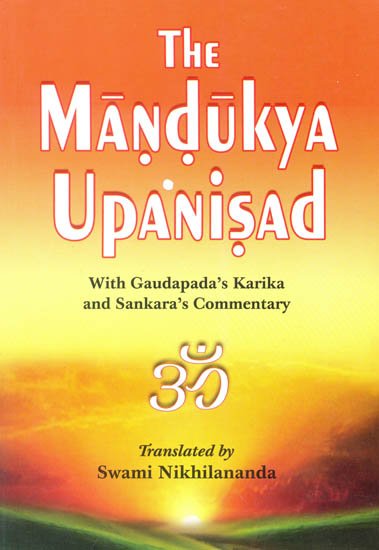Mandukya Upanishad (Gaudapa Karika and Shankara Bhashya)
by Swami Nikhilananda | 1949 | 115,575 words | ISBN-13: 9788175050228
This is verse 1.10 of the Mandukya Karika English translation, including commentaries by Gaudapada (Karika), Shankara (Bhashya) and a glossary by Anandagiri (Tika). Alternate transliteration: Māṇḍūkya-upaniṣad 1.10, Gauḍapāda Kārikā, Śaṅkara Bhāṣya, Ānandagiri Ṭīkā.
Mandukya Karika, verse 1.10
Here appear the following ślokas:—
Sanskrit text, IAST transliteration and English translation
निवृत्तेः सर्वदुःखानामीशानः प्रभुरव्ययः ।
अद्वैतः सर्वभावानां देवस्तुर्यो विभुः स्मृतः ॥ १० ॥nivṛtteḥ sarvaduḥkhānāmīśānaḥ prabhuravyayaḥ |
advaitaḥ sarvabhāvānāṃ devasturyo vibhuḥ smṛtaḥ || 10 ||10. In it, indicated as the changeless and the Supreme Lord, there is a cessation of all miseries. It is the one without a second among all entities. It is known as the Turīya (Fourth), effulgent and all-pervading.
Shankara Bhashya (commentary)
In (the Knowledge of) Īśāna, meaning the Turīya Ātman there is a cessation1 of all miseries characterised by the three states, viz., Prājña,2 Taijasa and Viśva. The word ‘Īśāna’ is explained as ‘Prahhu’, i.e., the one who brings about the cessation of miseries. It is because misery is destroyed by one’s own Knowledge of it (Turīya). ‘Avyaya’ means that which is not subject to any change, i.e., which does not deviate from its own nature. How? It is so because Turīya is non-dual, all4 other entities being illusory (unreal) like the idea of the snake, etc., imagined in the rope. It is he who is recognised5 as the Deva (on account of his effulgent nature), the Turīya, the fourth, the Vibhu,6 that is the all-pervading one.
Anandagiri Tika (glossary)
1 Cessation—The three states are said to be in the Ātman because we, as Turīya, cognize them. Therefore all misery as well as its cause associated with the three states, are imagined by us to subsist in Turīya. It is because we do not realise this that we identify ourselves with the states and that we suffer from various kinds of miseries. But a complete cessation of miseries ensues if we realise the Ātman as Turīya and thus witness the appearance and disappearance of the ideas, viz., the states without identifying ourselves with them.
2 Prājña—The state of Suṣupti, devoid of the Knowledge of Turīya on the part of the sleeper, is characterised as unhappiness.
3 Knowledge—Though Turīya is constant in all the states, yet we suffer from misery because we are not aware of the existence of the Turīya. It is only the Knowledge of Turīya that can destroy misery.
4 All other, etc.—Though Viśva, etc., are perceived, they are really illusory like the ideas of the snake, etc., in the rope. Turīya alone is real. Every part of Viśva, Taijasa arid Prājña is nothing but Turīya as every part of the illusory snake is the rope. Therefore from the highest standpoint only Turīya is.
5 Recognised—That is Turīya, as such, is known from the realisation of the wise.
6 Vibhu—Turīya is called Vibhu because it pervades all the three states.
